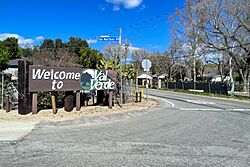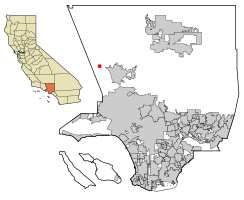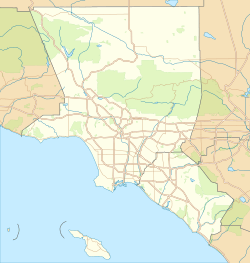Val Verde, California facts for kids
Quick facts for kids
Val Verde, California
|
|
|---|---|

Welcome sign at San Martinez Road and Chiquito Canyon Road
|
|

Location of Val Verde in Los Angeles County, California.
|
|
| Country | |
| State | |
| County | |
| Settlement | 1920s |
| Area | |
| • Total | 2.565 sq mi (6.644 km2) |
| • Land | 2.565 sq mi (6.644 km2) |
| • Water | 0 sq mi (0 km2) 0% |
| Elevation | 1,188 ft (362 m) |
| Population
(2020)
|
|
| • Total | 2,399 |
| • Density | 935.3/sq mi (361.08/km2) |
| Time zone | UTC-8 (PST) |
| • Summer (DST) | UTC-7 (PDT) |
| ZIP code |
91384
|
| Area code(s) | 661 |
| FIPS code | 06-81967 |
| GNIS feature ID | 1661607 |
Val Verde (), which means "Green Valley" in Spanish, is a small community in Los Angeles County, California. It's nestled in the foothills of the southeastern Topatopa Mountains. Nearby communities include Valencia and the city of Santa Clarita. In 2020, about 2,399 people called Val Verde home. The U.S. Census Bureau counts Val Verde as a special statistical area.
Contents
Exploring Val Verde's Location
Val Verde is found in the San Martinez Chiquito Canyon. This area is in the foothills of the Topatopa Mountains. It sits about 1,250 to 1,400 feet (381 to 427 meters) above sea level. A small creek flows through the community sometimes. Val Verde is about 50 miles (80 km) northwest of downtown Los Angeles. It is also west of Valencia and Santa Clarita.
The community covers about 2.565 square miles (6.644 square kilometers) of land. There is no water area within its borders.
Nature and Plants in Val Verde
The natural environment here is home to plants like coastal sage scrub and chaparral. You can see many old trees around Val Verde. These include native Coast Live Oaks and California Sycamores. Other trees, like River She-Oak and Deodar Cedar, were planted in Val Verde Park.
A Journey Through Val Verde's Past
The land where Val Verde is today was once home to the Tataviam people. They lived in this region long before the 15th century. One of their villages, Chaguibit, was close by.
Spanish and Mexican Influence
Spanish explorers arrived in the late 1700s. They built the San Fernando Rey de Espana Mission in 1797. Native people were moved to the mission and encouraged to convert to Christianity. By 1810, most of the Tataviam people were living at the mission. In 1804, the Spanish started using the Santa Clarita Valley for farming. They built a small farm called an Estancia near the Santa Clara River.
After Mexico became independent, the mission lands were sold off. These lands became large farms called ranchos. The land was supposed to go back to the native people. However, this did not happen. The farm lands were sold as Rancho San Francisco in 1839.
In 1842, gold was found in Placerita Canyon. This led to a small gold rush in the area. Mexican settlers came to mine for gold. The first settlement in Val Verde was a short-lived mining town. During the Mexican–American War, the mine was destroyed. This was done to keep the United States from getting control of it. The rancho eventually came into the hands of Henry Newhall in 1862.
Val Verde Ranch and a New Beginning
In the early 1900s, the Janes family owned a large property. It was called the Val Verde Ranch. Laura C. Janes, a wealthy woman, opened her ranch to African Americans. This was because they faced discrimination and were often not allowed in public places. A group of African American leaders from Los Angeles wanted to create a place for their families to relax. This group included Sidney Preston Dones, Norman O. Houston, and Charlotta Bass. They connected with Laura C. Janes.
Eureka Villa and Val Verde's Growth
In 1924, the community we know today was founded. It was started by Sidney P. Dones and his group. They called it Eureka Villa. It was planned as a resort for African Americans. At that time, many public beaches and pools did not allow African Americans. Val Verde became known as the "Black Palm Springs." It was very popular in the 1930s. This was because it was one of the few places African Americans could go for fun.
Other places for African Americans in Southern California included Lake Elsinore and a part of Venice Beach. There was also Bruce's Beach and a park in Pasadena that was only open to African Americans one day a year.
Two areas of land were sold: Eureka Villa and Val Verde. Eureka Villa was along Chiquito Canyon Road. Val Verde covered the east-west area. Advertisements encouraged Black Angelenos to buy land for vacation homes. Lots started at $75. Later, Harry M. Waterman, another landowner, took over selling the Val Verde lots.
In 1927, 53 acres (21 hectares) were given to the county by landowners. This land became Val Verde Park. By then, the area was simply called Val Verde. Cafés, restaurants, and nightclubs opened. Motels and campgrounds also appeared. Famous entertainers like Ella Fitzgerald and Lena Horne visited the town.
By 1939, over fifty homes had been built. The park continued to be a popular gathering spot. In 1939, a new Olympic-sized swimming pool was started. Actress Hattie McDaniel attended the ceremony. The original pool was damaged in the 1994 Northridge earthquake. It has since been repaired.
In 1942, Leon Perdue became the first African American director of Val Verde Park. He worked to create many community programs. These included beauty pageants, dances, and Christmas events. In 1945, William S. Hart High School was built. This meant students no longer had to travel far for school.
In the 1950s and 60s, local jobs were at Thatcher Glass and other companies. African Americans were still the main group living in Val Verde. A Baptist church opened in 1953. In 1951, the Val Verde Improvement Association worked to improve the community's water system.
Marguerite Carr became president of the Val Verde Chamber of Commerce in 1960. She had started "Goodwill Relationship Day" in 1952. This event brought different racial groups together. She also helped open a post office branch in 1956.
Even though Val Verde was a safe place for African Americans, they still faced challenges. In 1964, a home owned by a Black World War II veteran was burned down. This was due to racial tensions in the area.
Val Verde After the 1960s
After the 1960s, new laws made racial segregation illegal. Many African Americans moved to larger areas they could not live in before. Farm workers from nearby areas began to move to Val Verde. Today, the town has many Latino and White residents.
By the 1970s, the population was about 500 people. In 1973, 126 new homes were built. In 1971, the California Institute of the Arts opened nearby. Some instructors and alumni moved to Val Verde. By the 1980s, the population grew to between 600 and 1,000 people. Many vacation homes became old and run-down. In 1980, officials said half the houses were not in good condition.
In the early 1990s, there were concerns about the Chiquita Canyon Landfill. It had been built near the community in 1971. As part of a deal, the landfill now helps fund scholarship programs for the community.
The 1994 Northridge earthquake caused a lot of damage in Val Verde. Most of the old buildings were hurt. The community pool was damaged but has been repaired. It is now part of the Los Angeles County Park system.
In 2011, a company tried to build a large cell phone tower near homes. Residents protested, saying it was too close. By 2013, the company decided to build the tower on a hillside away from homes.
In 2017, law enforcement found many birds used for illegal activities at a ranch in Val Verde. It was one of the largest such findings in U.S. history.
Who Lives in Val Verde?
Val Verde is a diverse community. In 2020, the total population was 2,399 people. The median age was about 35.8 years old.
Many different backgrounds make up the community:
- About 34% of residents are White.
- Around 3% are African American.
- About 1.8% are Native American.
- Roughly 2.9% are Asian.
- About 0.2% are Pacific Islander.
- Around 37% identify as another race.
- About 21% identify with two or more races.
- Overall, about 64.6% of residents identify as Hispanic or Latino.
Most people in Val Verde live in family homes. In 2020, there were 689 households. About 58% of these were married couples. Many households had children under 18. About 85% of homes were owned by the people living in them. The rest were rented.
Val Verde's Economy
Val Verde has a convenience store for residents. There is also a rustic ranch with cottages for rent. A family farm grows organic produce. The community is also home to the 250-acre (101-hectare) SilverStrand movie ranch.
Getting Around Val Verde
You can get into Val Verde from the north and south using paved roads. Chiquito Canyon Road comes from the south. Del Valle Road comes from the north. Most residential roads are paved, but there are no paved sidewalks. San Martinez Road is the main east-west road.
The City of Santa Clarita Transit bus service has a route that goes through Val Verde. It has stops on Chiquito Canyon Road, San Martinez Road, and Del Valle Road.
Homes in Val Verde range from wood-frame houses to larger multi-bedroom homes. Most homes use septic tanks for sewage.
See also
 In Spanish: Val Verde (California) para niños
In Spanish: Val Verde (California) para niños




